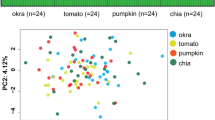Abstract
Populations ofAnagrus epos Girault are being imported and evaluated for the biological control of variegated grape leafhopper,Erythroneura variabilis Beamer, a newly introduced pest of grapes in central California. To distinguish different biotypes, a field test was developed that quantifies host preference.E. epos collected from geographically isolated regions of western United States and northern Mexico showed different levels of preference towards the variegated leafhopper and its close relative the grape leafhopper,Erythroneura elegantula Osborn, a native to central California. Host preference values may aid in the identification of relased biotypes using leafhopper eggs on leaves sampled from release sites.
Résumé
Plusieurs biotypes d'Anagrus epos Girault [Hym.: Mymairdae] ont été importés et évalués pour la lutte biologique contre la cicadelleErythroneura variabilis Beamer, espèce nuisible à la vigne en Californie centrale. Nous avons développé une méthode pratique qui quantifie par un coefficient la préférence. Les biotypes d'Anagrus epos venant de zones géographiques isolées différentes de l'ouest américain et du nord du Mexique ont montré divers degrés de préférence pour les 2 espèces principales de cicadelles. Les mesures de la préférence des biotypes, élevés en laboratoire peuvent fournir des caractères propres à identifier les individus libérés sur le terrain.
Similar content being viewed by others
References
Chesson, J. — 1978. Measuring preference in selective predation. —Ecology, 59, 211–215.
Chesson, J. — 1983. The estimation and analysis of preference and its relationship to foraging models. —Ecology, 64, 1297–1304.
Cook, L. M. — 1971. Coefficients of natural selection. —Hutchinson, London, Great Britain.
Gerald, G. — 1966. Food habits of longnose daceRhinichthys cataractae. —Copeia, 1966, 478–484.
Gonzalez, D., Cervenka, V., Moratorio, M., Pickett, C. &Wilson, L. T. — 1988. Biological control of variegated leafhopper in grapes. —Calif. Agric., 42, 23–25.
Hafez, M. &Doutt, R. L. — 1954. Biological evidence of sibling species inAphytis maculicornis (Masi) [Hym.: Aphelinidae]. —Can. Entomol., 86, 90–96.
Hearn, A. B., Ives, P. M., Room, P. M., Thomson, N. J. &Wilson, L. T. — 1981. Computer-based cotton pest management in Australia. —Field Crops Research, 4, 321–332.
Huffaker, C. B., &Kennett, C. E. — 1966. IV. Biological control ofParlatoria oleae (Colvee) through the compensatory action of two introduced parasites. —Hilgardia, 37, 283–335.
Ivlev, V. S. — 1961. Experimental ecology of the feeding of fishes. —Yale Univ. Press, New Haven, Connecticut, U.S.A.
Kido, H., Flaherty, D. L., Bosch, D. F. &Valero K. A. — 1984. The variegated grape leafhopper in the San Joaquin Valley. —Calif. Agric., 38, 31–32.
Manly, B. F. J., Miller, P. &Cook, L. M., — 1972. Analysis of a selective predation experiment. —Amer. Nat., 106, 719–736.
Murdoch, W. W. — 1969. Switching in general predators: experiments on predator specificity and stability of prey populations. —Ecol. Monogr., 39, 335–354.
Pickett, C. H. Wilson, L. T., Gonzalez, D. &Flaherty, D. L. — 1987. Biological control of variegated grape leafhopper. —Calif. Agric., 41, 14–16.
Paulik, G. J. &Robson, D. S. — 1969. Statistical calculations for change-in-ratio estimators of population parameters. —J. Wildlife Manage., 33, 1–27.
Rosen, D. &DeBach, P. — 1979. Species ofAphytis of the world [Hym.: Aphelinidae]. —Israel Univ. Press, Jerusalem. 801 pp.
Settle, W. H., Wilson, L. T., Flaherty, D. L. &English-Loeb, G. M. — 1986. The variegated leafhopper, an increasing pest of grapes. —Calif. Agric., 44, 30–32.
Wilson, L. T. — 1977. The Biology ofHeliothis zea (Boddie) on Cotton. —Ph. D. Dissertation, Univ. of Calif., Davis, California, U.S.A., 95616.
Wilson, L. T. &Gutierrez, A. P. — 1980. Fruit predation submodel:Heliothis larvae feeding upon cotton fruiting structures. —Hilgardia, 48, 24–36.
Wilson, L. T. &Waite, G. K. — 1982. Feeding pattern of AustralianHeliothis on Cotton. —Environ. Entomol., 11, 297–300.
Author information
Authors and Affiliations
Rights and permissions
About this article
Cite this article
Pickett, C.H., Wilson, L.T., Flaherty, D.L. et al. Measuring the host preference of parasites: An aid in evaluating biotypes ofAnagrus epos [Hym.: Mymaridae] . Entomophaga 34, 551–558 (1989). https://doi.org/10.1007/BF02374393
Received:
Accepted:
Issue Date:
DOI: https://doi.org/10.1007/BF02374393




